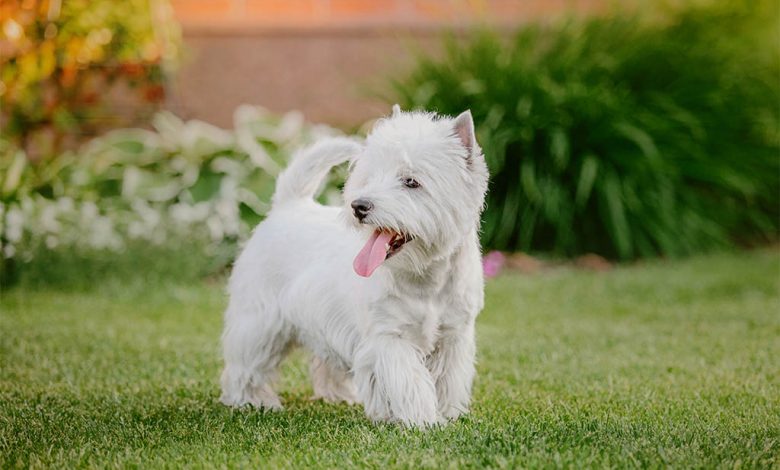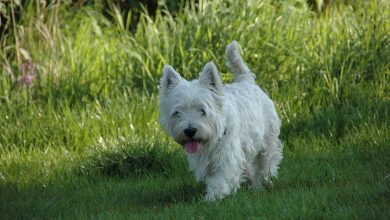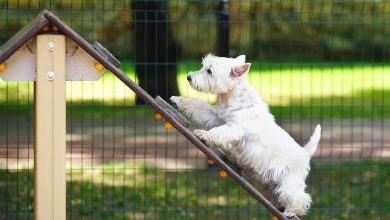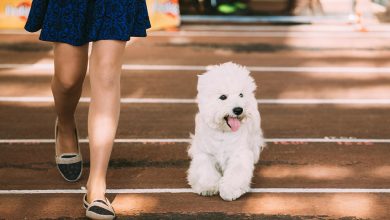From hydrotherapy and weight management to supplements and lifestyle changes. learn how to help your Westie’s pain.
By Imogen Ratcliffe
Osteoarthritis, or ‘arthritis’ as it is most commonly known, is one of the most prevalent chronic conditions amongst dogs. Primarily, arthritis is the degeneration of joint cartilage which has secondary effects on surrounding muscles, ligaments, and tendons. The pain associated is described as ‘chronic’ meaning ‘long term’. However, arthritis is not always easy to spot as dogs may not appear overtly lame. Instead, pain may manifest in behavioural changes, postural adaptations, muscular changes, or an altered walking pattern. Although it is believed to be a disease of the elderly, studies estimate that 35% of dogs over the age of two suffer from the chronic condition. Whilst 80% of dogs over the age of eight battle with this long-term diagnosis. Unfortunately, there is no cure for arthritis, instead, treatment involves managing the symptoms associated with the disease. Treatment should involve a multimodal approach including pain relief prescribed by your vet, complementary therapies such as physiotherapy or hydrotherapy, weight management, joint supplements, and alterations to the home environment.
Is Your Westie Having Too Much Exercise?
So, how should dogs clinically diagnosed with arthritis be exercised? The golden rule is little and often. Short frequent exercise is best to encourage synovial fluid to the joints, prevent tissue contracture and maintain muscle mass. Long, infrequent exercise is not suitable for those clinically diagnosed with arthritis as it places excess strain on the joints and can cause delayed onset muscle soreness. ‘Weekend warriors’ as they are commonly known are dogs that are only exercised during the weekend for long periods. This exercise regime is not suitable for those with arthritis. Instead, a daily regimen of short frequent walks should be implemented. Following diagnosis, your normal daily walk divided into two or three separate walks is a good rule of thumb, although this will vary between individual cases, so speak to your vet or veterinary physiotherapist.
Slow lead walking with some off-lead exercise is beneficial for those with the condition. Walking slowly on the lead encourages equal weight-bearing through all four limbs, therefore reducing the likelihood of gait adaptations or compensatory movement. However, this doesn’t mean walks should always be on the lead, short bursts of off-lead exercise are beneficial to maintain cardiovascular fitness and to provide mental stimulation particularly for young dogs.
Slipping and Sliding
Walking on varied surfaces, including grass and pavement, is beneficial for your dog. Believe it or not, varying walking surfaces provide neuromuscular feedback which improves ‘proprioception’ and coordination. Varying the walking surface is also a form of canine enrichment. Soft, non-slip surfaces are best for those clinically diagnosed with arthritis as the concussive forces are less than those experienced on hard surfaces. Dogs that are consistently exercised on hard ground only are exposed to excessive concussive forces which can negatively impact joint health and even predispose arthritis.
It is also important to reduce your dog’s interaction with slippery flooring at home. Unsuitable flooring is a huge contributing factor to injury and joint disease and is often overlooked by owners. Dogs with arthritis are already less inclined to get up, therefore ensuring the home environment is suitable is of the utmost importance. Slipping and sliding is a contributing factor to injury, postural muscle tension and can lead to a downward spiral of injury and weakness. Make sure your home environment is suitable by introducing rugs and floor runners in the house to increase traction.
Play Time
Avoid high intensity, repetitive exercise including ball throwing. Those who are particularly ball-driven can over-exert themselves when retrieving balls and inflict injury. Playing fetch encourages fast acceleration and heavy braking which is not recommended for those with osteoarthritis. Furthermore, those who retrieve balls are exposed to greater torsion which can negatively impact joint health. Instead of throwing the ball with a ball thrower, opt for rolling it or taking it away altogether.
Lastly, tailor your dog’s exercise to their behaviour and presentation on the day. If your dog seems stiffer or is showing signs of lameness, reduce their walking distance that day. Replace the lost walking time with some brain-stimulating games or toys. Similarly, if your dog seems to be coping well with their daily exercise, increase your walk by increments of five minutes each week and monitor them closely for any alterations in gait. The aim is to maintain muscle mass without putting excess stress through the joints.
If you suspect your dog may have arthritis, contact your vet for more information and support. Rehabilitation is a rapidly growing area of veterinary medicine, with increasing research supporting its clinical benefit and application. Ask your vet if they think your dog is a suitable candidate for physiotherapy or hydrotherapy to support their condition. Your veterinarian will need to give consent prior to any alternative therapies.
Imogen is a BSc (Hons) Veterinary Physiotherapy graduate affiliated with the National Association of Veterinary Physiotherapists (NAVP). With experience in neurological and orthopaedic rehabilitation at a purpose-built veterinary hospital. Imogen also runs her own physiotherapy business specialising in canine sports maintenance and rehabilitation. As the proud owner of three dogs, Imogen is passionate about canine rehabilitation and its integration into veterinary medicine.






